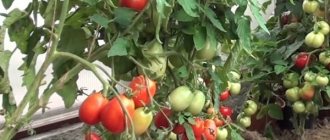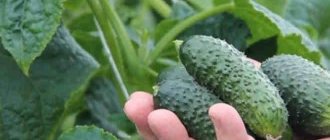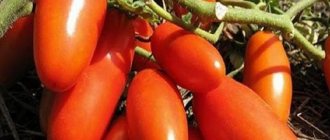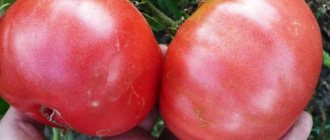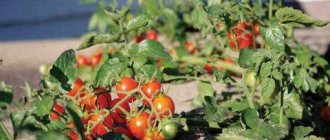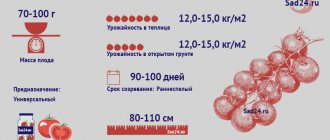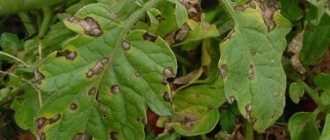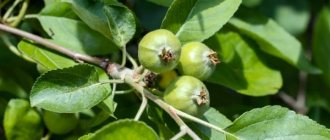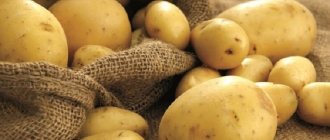The Pudovik tomato is an achievement of a team of Novosibirsk breeders, in particular V. N. Dederko and O. V. Postnikova. The variety has been noted in the State Register of Breeding Achievements of the Russian Federation since 2007, and is approved for cultivation in all regions in open and closed ground.
According to the description and characteristics, Pudovik has few disadvantages; in reviews about it, gardeners not only share the secrets of growing it, but also leave photos of attractive-looking, large fruits.
Full description with the opinion of those who planted
Description of plant form
"Pudovik" is an indeterminate variety. The height of an adult bush can easily reach 180-200 cm. The bush is powerful, spreading, the leaves are large, of a typical tomato appearance.
By sowing seeds at traditional times, you will not expect rapid fruiting; it will rather be mid-season. To slightly speed up the enjoyment of a delicious tomato, you can sow the seeds in the last days of February.
The plant form requires constant care. Stepchildren are a mandatory procedure, although “Pudovik” is not very powerful in the formation of stepchildren.
Tomato shoots grow quickly, they are massive and heavy. Without tying, the lashes quickly fall under their own weight, so tying must be carried out constantly.
Description of fruits
The “Pudovik” tomato produces fruits on simple inflorescences, and its stalk is without articulation.
Unfortunately, seed packers mislead customers by depicting smooth fruits on the label of seed packets. They depict the shape correctly, heart-shaped, but the fruit does not show smoothness - it is ribbed.
The tomatoes are medium in density and don’t want to sit for too long. Vegetable growers who grew the variety speak of it as very tasty, but not one that can sit for a long time and wait for consumption.
During the ripening period, tomatoes have a bright green color. The ripe fruit is crimson. When cut, four nests are clearly visible. Each one is filled with pulp and seeds.
Often gardeners confuse varieties and “Pudovik” is passed off as “one hundred pounds”. However, these varieties are completely different both in shape and in the color of the ripe fruit. In addition, the “Pudovik” variety has a much better taste and much (almost twice) higher yield.
Separately, the taste of the tomato should be noted. Those who grew tomatoes repeatedly claim that “Pudovik” is the most delicious tomato of all the tomato inhabitants of the garden. The tasting commission, when determining the properties, gave it an “excellent” rating. The tomato has a pronounced tomato taste, an excellent balance of acids and sugars, as well as pleasant, tender pulp.
Some vegetable growers are concerned about fruit fibrousness. However, those who are constantly involved in improving agrotechnical parameters deny such data and say that with good care this has never been observed.
By weight, tomatoes are large. The average fruit weight varies between 280-320 g. There is evidence that tomatoes often exceed a weight of 400 g.
Appearance
In appearance, the fruits of the Pudovik tomato resemble the fruits of the Siberian varieties Velmozha and Heavyweight of Siberia, but the bulk of the tomatoes are larger in size. Both the shape and color of all these three varieties are completely identical, causing a feeling of excellent taste and sweetness, which is justified when tasting tomatoes.
In appearance, Pudovik tomatoes are typical large raspberry-colored hearts
Resistance to diseases and pests
The registration commission does not provide instructions on the resistance of a variety to a specific type of pathogen.
Following this information, tomatoes need preventive treatments. Those who have already grown do not highlight the special sensitivity of “Pudovik” to any pathogens or pests, but they also do not refuse prevention.
Experienced vegetable growers carry out the first treatment a month after planting, and then every 15-20 days, depending on weather conditions.
In order for treatments to have the greatest effect, it is recommended to alternate fungicidal preparations not only from year to year, but also from treatment to treatment.
Advantages and disadvantages
When grown in cool climates, Pudovik has proven to be a good, reliable variety. Its advantages:
- large fruit;
- productivity;
- grows in soil and greenhouse;
- great taste;
- disease resistance;
- high sugar content;
- beautiful fruits;
- universal purpose.
Disadvantages of Sevruga:
- requires gartering and pinching;
- fruits are prone to cracking;
- low drought resistance;
- average keeping quality;
- the fruits vary greatly in size.
Features of growing the variety
To speed up the arrival of delicious fruits to the table, you need to worry about the seedling period.
Let's grow strong seedlings
It is better to sow seeds at the end of February in nutritious, universal soils.
In the phase of two true leaves, seedlings are planted in individual containers.
Seedlings tend to stretch, so the best place for their growth will be a bright, southern window and not a high temperature.
The optimal temperature for the night is 14-16 ᵒC, and during the day no higher than 18-20 ᵒC. Such conditions will allow the seedlings to be compact.
Some vegetable growers, when growing tall varieties, use different technologies and methods to prevent them from overgrowing. Can be used:
- Pruning the root system;
- Decrease in temperature and increase in illumination;
- Treatment with growth suppressing drugs.
Tomatoes can be transplanted into open ground when return frosts are no longer possible. The age of the seedlings by this time should be 55-65 days.
Planting and care
The characteristics indicate that Pudovik is suitable for all regions, but it is better to plant the variety in cool climates.
In the south, it may not correspond to the description, although it bears fruit and requires increased attention. So it makes no sense to grow it there. Moreover, there are many other good-yielding tomato varieties for warm regions.
Sowing seeds
Seeds for seedlings are sown 55-60 days before planting. Tomatoes are placed in beds when the ground warms up to 15° C. In greenhouses - up to 10° C. The exact time depends on the region and weather forecasts.
You can focus on the following timing for sowing Pudovik tomatoes for seedlings:
| Regions | Greenhouses | Open ground |
| Middle lane | beginning – mid March | mid-March – early April |
| North-West, Siberia, Ural | second half of March | beginning – mid-April |
Features of care
In the Middle Zone and Siberia, the Sevruga tomato has proven itself, according to reviews, to be a fairly stable and not too demanding variety. It needs to be fed regularly so that the fruits become full and do not become smaller.
It is necessary to ensure that phosphorus-potassium fertilizers predominate in Pudovik’s “diet”. Nitrogen is definitely needed (it is the building material for the plant), but in very limited quantities. Otherwise, the tomato will increase its green mass to the detriment of fruiting and will become vulnerable to pests and pathogens.
The care package must include preventive treatments. The Pudovik tomato is quite demanding when it comes to watering. But it is impossible to over-moisten the soil - this leads to cracking of tomatoes, rot, and provokes the development of other diseases.
Bush formation
The Sevruga tomato variety requires pinching and tying to a support from an early age. The lower leaves are removed only when the ovary above them begins to fill. Pudovik can be grown in 1 or 2 trunks.
To obtain large tomatoes, pinch the brushes. To grow truly gigantic fruits weighing 1-1.5 kg, you will only have to leave a few ovaries on the bush.
Description and characteristics of the variety
The Sevruga tomato is mid-season, determinate, in greenhouses it grows up to 1.5-1.7 m. In open ground, the dimensions are more modest - from 1.2 to 1.5 m. When planted in the south, the bush can barely reach 100 cm.
Pudovik tomatoes form rather weak shoots, this is noted by everyone who planted the variety. The fruit load is large; without a garter, the bush will fall to the ground or break. Sevruga leaves have a regular shape, thin, and there are a moderate number of stepsons.
The first flowering raceme is formed after 6-7 leaves. Subsequent ones - after 2-3 internodes. Pedicels without articulations. The flowers are large.
Fruit characteristics
Sevruga tomatoes look like a heart with a slightly elongated nose (see photo). The color is reddish-crimson; often yellow spots remain on the sides hidden from the sun when fully ripe. The surface is slightly ribbed.
Tomato Sevruga is a typical beef. The pulp is fine-grained, with a high content of dry matter. In cross section it resembles fresh meat.
The Sevruga tomato variety produces few seeds, which makes it difficult to collect your own planting material.
The taste of tomatoes is very good, sweet, the sourness is barely noticeable. Pudovik is suitable for all types of processing, except for whole-fruit canning. But it is better to use these tomatoes for fresh consumption.
It should be taken into account that the juice from Sevruga will be thick and sweet, and will be enjoyed by children and adults. But it is not very suitable for preparing first courses.
Features of fruiting
The tomato variety Pudovik ripens in medium terms and forms large fruits even without rationing. The largest grow on the lower hands - up to 500 g. As they move upward, they become smaller and smaller, but rarely weigh less than 150 g.
The Sevruga tomato cannot boast of straightened fruits. Each cluster contains very large and relatively small tomatoes.
If the ovaries are normalized, leaving 2-3 pieces in each bunch, half-kilogram tomatoes will not be a rare exception, but an average size. Record holders of 1-1.5 kg can be grown by topping the bush and removing all but the best fruits. Then Sevruga will direct its forces to the formation and ripening of the remaining tomatoes.
Productivity
Pudovik bears fruit well in greenhouses and open ground. From one bush, a tomato yields up to 5 kg. If it is grown in 2 trunks, per 1 sq. m you can plant 3 bushes. The total weight of the fruits will not change, only their number will increase and the weight of each will decrease.
When formed into 1 shoot per 1 sq. m have 4 tomatoes. The yield will be 15 or 20 kg, respectively.
Bush care
Despite the modest parameters of the plants, they require the same care as most indeterminate tomatoes. “Sugar Pudovik” needs to be planted into 2 stems with a limit on the growth point after the formation of the 5th fruit cluster - otherwise the size of the fruits will not correspond to the nominal value. It is also recommended to remove leaves below the first cluster.
Other agricultural activities:
- Gartering the stem and installing supports for fruit clusters;
- Watering with settled warm water several times a week;
- Loosening the soil to prevent the formation of a dense earthen crust;
- Fertilizing with complex mineral fertilizers twice a season.
Description of fruits
One of the main advantages of this variety is its very high yield. The fruits are large and tasty. Moreover, they are quite strong, so they can be stored for a long time and can easily be transported over long distances.
When fully ripe, the tomato acquires a rich red color. The tomatoes are flat-rounded, but without the ribbing that often accompanies similar varieties. The tomato tastes sweet, so it is good for making salads.
The average weight of 1 fruit is 400 g. Such dimensions do not allow the use of Sugar Pudovich tomatoes for whole-fruit canning. But pickling in slices, preparing sauces and juices will be a completely suitable method for processing the tomato harvest.
Tomatoes have thin skin, but dense pulp with a high dry matter content. Therefore, they do not deteriorate or wrinkle during storage or during transportation. This makes the tomato convenient for industrial cultivation.
Reviews about this variety are usually positive.
Larisa, Volgograd: “There has never been such a tomato harvest before. I took the hybrid Sugar Pudovik for the first time. I am very pleased with the quantity and quality of the fruit. But the bushes require a lot of care. This variety is not for lazy summer residents!”
Marina, Leningrad region: “Excellent tomatoes that set in large quantities even in cool weather. A good option for those who have small summer cottages.”
Advantages and disadvantages
The Pudovik variety is preferred by many gardeners to grow, as it has the following advantages:
- excellent taste;
- resistant to diseases;
- growing tomatoes in any environment;
- fruits are well preserved during transportation;
- high productivity and long fruiting;
- tomatoes are unpretentious to growing conditions and do not require special care;
- versatility of use: cooking various dishes, canning, etc.
The disadvantages of the variety include:
- bushes need to be tied up and pinched;
- if the crop grows in conditions of high humidity, the fruits may crack.
This variety does not have any significant disadvantages, which is why more and more people are growing Pudovik in their garden plots.
Farmer reviews
Despite the existing shortcomings, reviews of the culture are positive. Here are some opinions from gardeners:
Galina, Novokuznetsk: “ The tomatoes began to grow large, up to 600 g, tasty, fleshy, fragrant, with a small amount of seeds. But these seedlings were the first to get sick. The leaves turned brown and began to dry out. I didn’t wait, I picked the tomatoes unripe. The vegetables picked up color perfectly on their own at room temperature. The taste was amazing. I’d like to plant it again because of the taste.”
Galina, Omsk: “I planted the Sugar Pudovichok tomato variety for the first time. The height reached 2 m. The productivity is high, the immunity is strong - the plants did not suffer from anything throughout the season. The tomatoes are large, tasty, with sugar on the break. It was enough to eat in the summer and wind up for the winter. I'm very pleased. I collected the seeds myself for planting next year.”
Form plants into 2 trunks
| Stage 1. Planting seedlings Step 1. Recommended planting time is the second half of May. The area is fertilized and dug up. Step 2. Holes are made according to a 50x70 cm pattern. After planting, the plants are watered abundantly | |
| Stage 2. Watering Step 1. A day before work, pour water into containers to let it settle and heat up. Step 2: Water in the evening after sunset. Water consumption per bush – 5-7 liters | |
| Stage 3. Weeding and loosening Step 1. Loosen the surface around the stems after each watering, as well as after rains. Step 2. Weed the area at least twice a month | |
| Stage 4. Feeding Step 1. Purchase a complex fertilizer for tomatoes. This is the simplest and most effective option. Step 2: Apply fertilizer every 3 weeks. Follow the dosage recommended by the manufacturer | |
| Stage 5. Garter and formation of bushes Step 1. A peg is driven in near each plant, to which the stem is tied in 2-3 places. Step 2. Form the plant into 2 trunks, leaving a shoot under the first flower cluster. The remaining shoots break off | |
| Stage 6. Timely collection of labor Step 1. Remove ripe fruits so that the plant does not waste resources on them. Step 2. Remove all spoiled and rotten tomatoes |
We invite you to familiarize yourself with: The best varieties of coffee beans in the world.
Description and characteristics of the Pudovik tomato variety, reviews, photos
Mid-season, medium-growing, high-yielding, large-fruited tomato variety. In the middle zone, it is recommended to grow it in a greenhouse.
The bush is of indeterminate type, 1.3-1.5 meters high, requires tying to a support and pinching. The best results were obtained when forming a plant with 2 or 3 stems.
The leaves of this tomato are large and green. The inflorescence is simple.
Basic qualities of fruits
The fruits are heart-shaped, medium density, raspberry-red at maturity, weighing 300-500 grams (up to 800 g), fleshy, sweet, very tasty. These tomatoes are good for fresh consumption and making juices and sauces.
The tomato variety Pudovik is included in the State Register of the Russian Federation for cultivation in open ground and under film covers on private farms.
Seed producer : agricultural company Siberian Garden.
Originator of the variety : Dederko, Postnikova.
Harvest and storage
Tomatoes should be harvested when the fruits have just begun to turn brown. In the warmth, they will ripen in a week, and their taste will be no different from tomatoes picked from the bush.
Wooden boxes are best suited for storing tomatoes. Dry, whole, healthy fruits need to be packed tightly into them. Place these boxes in a cool place, preferably non-residential and ventilated. Using this method, tomatoes will last for 2 months. Thus, in order for the beds to delight you with a rich harvest of tomatoes, you need to adhere to the basic rules. Grow with pleasure and enjoy delicious fruits.
Stages of planting Sevruga tomato seedlings and transplanting into open ground
This variety is recommended to be grown in seedlings, and Sevruga seeds should be sown throughout March
. The specific timing of planting Pudovik tomatoes is calculated based on the specific climatic conditions of the growing region, because seedlings are planted in a permanent place at the age of 2 months.
TOMATO VARIETIES!
Tomato Mongolian dwarf Tomato Raspberry flame F1 Tomato BATYANYA
Seed preparation
Typically, purchased seeds do not require pre-treatment; it is enough to soak them in a solution of a growth stimulator for germination.
If Sevruga seeds were collected from your own garden, then they are prepared for planting as follows:
- first, the seed material is placed in salt water; only those seeds that have sunk to the bottom of the container are suitable for planting;
- then the seeds are placed briefly in a weak solution of potassium permanganate for disinfection;
- Before planting, the seed material should be dipped in a growth stimulator solution for germination.
Photo of seed preparation
Preparing soil and containers
Usually, for planting seeds for seedlings, ready-made soil for growing vegetable seedlings is purchased in specialized stores.
But many vegetable growers prefer to prepare the nutrient substrate at home. To do this, mix garden soil, humus and river sand in equal parts. For looseness and fertility, sphagnum moss and wood ash are added to the resulting soil mixture.
Before putting it into containers, the soil prepared at home must be disinfected. To do this, the soil is shed with a weak solution of potassium permanganate.
Containers should also be disinfected with potassium permanganate before sowing seeds.
Planting Sevruga tomato seeds and further care of seedlings
The seeds are buried 1-1.5 cm into the soil, watered with a spray bottle and the containers are covered with polyethylene on top. The containers are placed in a bright, warm place until shoots emerge.
Typically, Sevruga tomato seeds germinate in 6-8 days, and the germination rate of the seed material is close to 100%.
After friendly shoots appear, the film is removed from the containers, and the containers themselves are transferred to the windowsill.
Usually, when growing Pudovik tomato seedlings, it is advisable to maintain a room temperature of 21-22 degrees Celsius.
Caring for Sevruga tomato seedlings involves regular watering. In this case, the top layer of soil should always be moist.
After a pair of true leaves appear, the thickened plantings need to be picked into separate containers.
Sowing tomatoes for seedlings. Dates and methods of sowing - video
Sevruga seedlings are fed twice during cultivation. The first time nitrogen fertilizers are applied 12-14 days after picking. The next feeding should be done a couple of weeks after the first.
A couple of weeks before transplanting tomato seedlings to a permanent location, they should be hardened off. To do this, the plants are taken out into the fresh air - at first for a short time, gradually increasing the time the seedlings stay outside.
INTERESTING!
Iodine for tomatoes against late blight
Planting in a permanent place of growth
Strengthened Pudovik tomato seedlings are planted in open ground in a permanent place when the soil has warmed up sufficiently and the air temperature does not drop below 15-16 degrees Celsius.
The soil should be fertilized before planting - at least 6 kg of organic matter, 1 cup of wood ash, as well as mineral fertilizers containing phosphorus and potassium are added to each square of area. The beds are dug up and loosened.
No more than 3 Sevruga tomato bushes are planted on each m2. After planting, the plants are watered and the root zone is covered with a layer of mulch.
